By Ope Ani
The Nigerian equities market recently came to the end of a busy earnings season. Among our covered banks, ACCESSCORP, GTCO, STANBIC, UBA and ZENITHBANK published Q1 2022 unaudited results.
It has been a challenging 2022 thus far for Nigerian banks’ stocks. Year-to-date, the sector index has returned a disappointing 7.4% and has grossly underperformed the broader equity gauge (NGX-ASI: +24.3%). Notably, it is the second-worst performing sector index. Stock performance within our coverage universe tells a similar story: FBN Holdings (+4.8%) and Access Holdings (+3.8%) have recorded small gains, UBA has been flattish, while GT Holdco (-8.1%), Stanbic IBTC Holdings (-8.3%), Zenith Bank (-
2.6%) have fallen. We discuss the reasons for the underperformance on Page 2.
Q1 22 was a decent quarter in terms of earnings for our covered banks. Four of the five banks which published results reported EPS growth; GTCO surprisingly reported an EPS decline. Notably, most of the growth across our coverage was driven by increased funded income, following the expansion in banks’ loan books and some upward repricing of loans. Higher yields in Q1 22 (vs Q1 21) also saw banks earn higher interest on their investment securities portfolios y/y. Overall, banks’ Yields on Assets (YoA) were much improved compared with the prior year. Elsewhere, banks’ Cost of Funds faced some upward pressure: however, they were able to keep rises below the rise in yields. As a result, Net Interest Margins (NIM) were resilient. Non-interest revenues (NIR) also continued on their upward trajectory.
The narrative that the fundamentals of the banking sector are compelling has persisted, even as investor apathy around bank stocks remains. In our view, although bank margins and profitability have come down slightly in recent years, bank stocks have been oversold. In an environment where negative inflation-adjusted yields remain the theme, bank dividends continue to offer more attractive yields than Treasury bills. In addition, with yields on the rise, we think FY 21 may have been the bottom in terms of banks’ profitability. The valuations of our coverage banks remain compelling and hold value for long-term investors, in our view.

Investor reaction to the banks Q1 22 results have largely been neutral. We proffer some reasons for this. First, the average gain in EPS (+11.6% y/y) of our covered banks is not that impressive in the context of inflation at 15.9%. Furthermore, stripping out the exceptional rebound in STANBIC’s EPS, the average gain in EPS (+5.7% y/y) is not all that impressive.
Second, the domestic equity market has got bigger fish to fry. For example, Brent oil price is sharply up (+38.2% y-t-d) and has propelled stocks like Seplat Energy (+84.6% y-t-d) to all-time-highs. In addition, palm oil prices are up sharply and have propelled stocks like Presco (+127.8% y-t-d) and Okomu Oil Palm (+51.4% y-t-d). Elsewhere, the telcos have been performing well, and their underlying growth is looking much better than the banks at the moment: MTN Nigeria grew revenue by 22.2% y/y and EPS by 31.5% y/y in Q1 22.
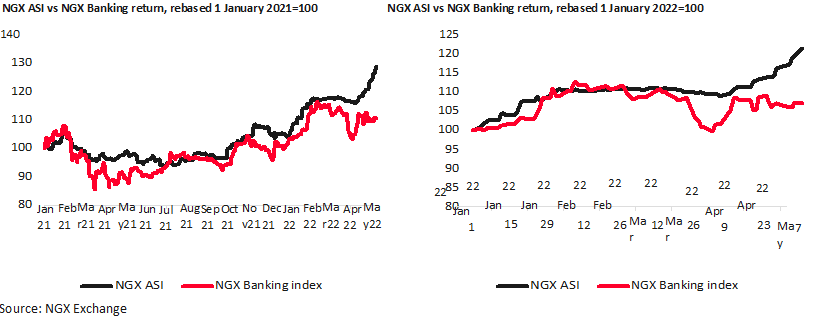
Third, the equity market now seems to be interested in some re-rates, like the Brewers, who reported better-than-expected numbers in Q1. So, the attraction of the banking sector is not so much an EPS growth story as a store of value.
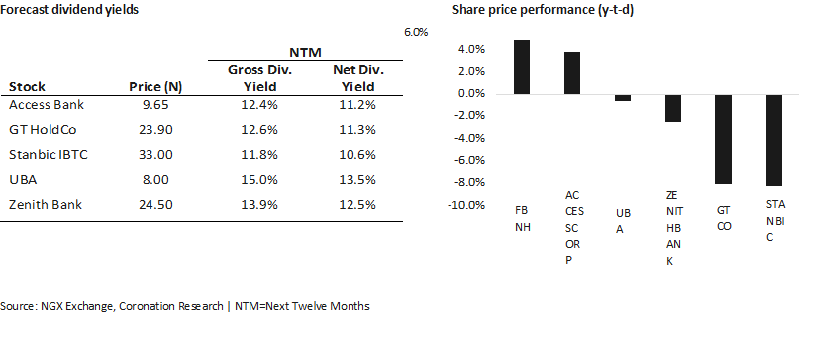
Zenith Bank (ZENITHBANK) | BUY, TP: N30.86
Q1 22: ZENITHBANK’s EPS grew by 9.5% y/y following solid growth in Net interest income (NII) (+20.9% y/y), which hit a quarterly record high of N100.54bn, and Non-interest revenue (NIR) (+11.8% y/y). The former was supported by solid loan growth (+5.8% y-t-d) and increased loan yields (+96bps y/y), while a surge in trading revenues (+231.1% y/y) drove the latter. However, on an annualised basis, the achieved EPS missed our and consensus FY 22 forecasts by 14.5% and 10.2%, owing to a negative surprise on the operating expense (Opex) line. Operating expenses surged 19.5% y/y on increased regulatory costs (AMCON and NDIC) and on the rise in Fuel and maintenance costs, which quadrupled (4.3x y/y), reflecting rising energy costs. For context, we estimate that Fuel and maintenance costs per branch rose from N1.8m in Q1 21 to N7.8m in Q1 22. Consequently, the group’s Cost-to-Income ratio rose 90bps to 52.6%.
We are encouraged by the fact that the group was able to not only substantially expand its loan book but was able to upwardly reprice its loans, benefitting its portfolio yield and NII. In addition, NIR is likely to continue to benefit from the execution of the group’s retail strategy. On the negative, we are concerned about the elevated operating expense profile. If the growth continues at this run rate, we are likely to increase our FY 22 Opex forecast post the H1 22 results release. Nevertheless, we maintain our BUY rating with a TP of N30.86. ZENITHBANK is trading at a 2022 P/B of 0.5x (ROAE: 19.9%), a discount to its SSA peer multiple of 0.6x and its five-year average of 0.8x.
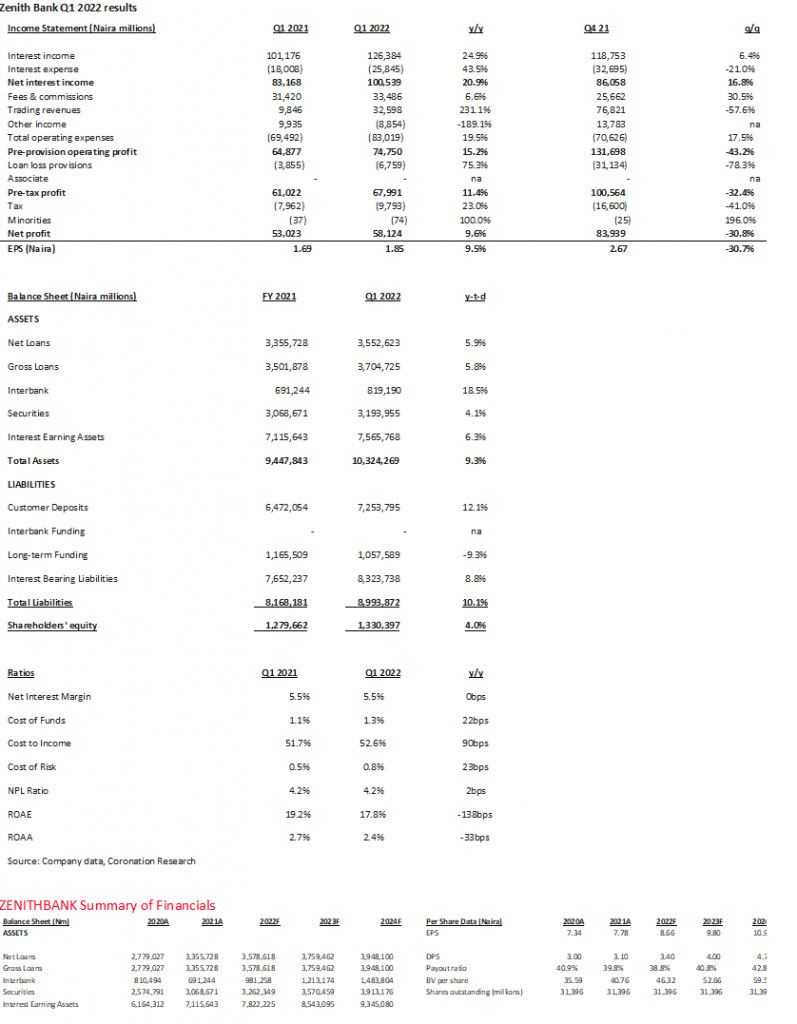
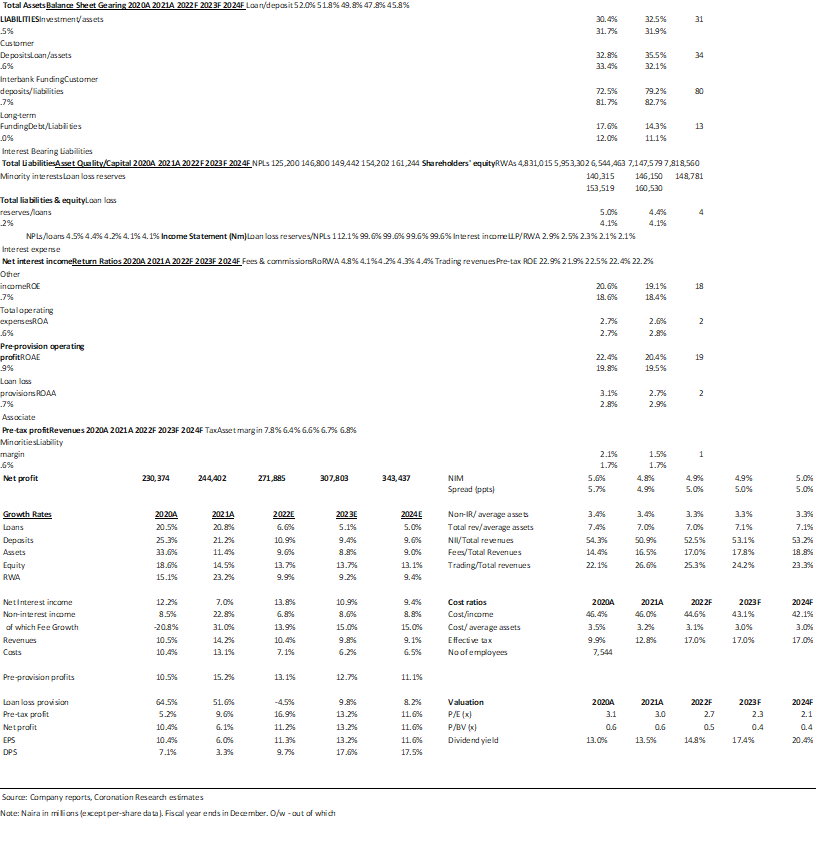
Guaranty Trust Holding Company (GTCO) | BUY, TP: N36.63
Q1 22: GTCO’s EPS declined by 5.6% y/y following a 20.9% y/y surge in Opex and a higher effective tax rate (20.4% vs 15.2% in Q1 21). The preceding offset the growth entirely in NII (+9.5% y/y) and NIR (+8.1% y/y). On an annualised basis, the achieved EPS missed our and consensus FY 22 forecasts by 10.4% and 9.8%, owing to the negative surprise on the operating expense (Opex) and NII lines. Opex surged 20.9% y/y on increased regulatory costs (AMCON and NDIC) but also on the rise in Administrative, communications and sponsorship (+137.5% y/y) and Human capital (+715.0% y/y) related expenses. Consequently, the group’s efficiency deteriorated, with its Cost-to-Income ratio rising by 469bps to 46.4%. On the NII miss, Interest income grew slower than we expected. We attribute this to the reduction in the group’s earning assets, which shrunk by 0.8% y-t-d, its first q/q fall since Q3 20.
GTCO results were unimpressive and are tracking behind our, consensus forecasts and management’s guidance. There was also no meaningful growth in the group’s balance sheet during the period, putting doubt on whether the group can effectively take advantage of the expected rise in domestic interest rates. Finally, we are concerned about the elevated opex profile; we will seek clarity from management on the non-regulatory cost drivers, although, at first sight, they seem to be acquisition-related costs. Nevertheless, we maintain our BUY rating with a TP of N36.63. The stock is trading at a 2022 P/B of 0.8x (ROAE: 21.6%), a justified premium to its SSA peer multiple of 0.6x, but at a discount to its five-year average multiple of 1.0x.
Guaranty Trust Holdco Q1 2022 results

Access Holdings (ACCESSCORP) | BUY, TP: N12.93
Q1 22: ACCESSCORP’s EPS grew by 9.4% y/y following solid growth in NIR (+54.9% y/y), which made up 55.4% of net revenue (Q1 21: 42.7%). The growth was primarily driven by trading revenues which surged 75.3% y/y following a substantial net foreign exchange gain of N85.8bn. On an annualised basis, the achieved EPS is ahead of our FY 22 forecasts by 8.7%, owing to better-than-expected NIR, which helped offset the miss in NII. Expressly, NII declined by 7.0% y/y as Interest expense surged 73.2%. The group’s Cost of Funds continues to face pressure, rising 74bps y/y, as the Current And Savings Account (CASA) mix deteriorated by 128bps y-t-d. Elsewhere, Opex also came in higher than expected following increased Premises and equipment costs, IT & e-business expenses and Personnel expenses (+45.8% y/y).
Overall, the results were impressive, considering the high base from the previous year. We expect strong growth in NIR to continue to drive earnings in FY 22. In addition, we are encouraged by the performance of the Rest of Africa business which grew PBT by 230.7% y/y and contributed 50.4% to the group’s PBT in Q1 22 (Q1 21: 16.5%). Like UBA (BUY, TP: N11.72), the performance highlights the diversification benefits of having Pan-African operations. The company is on track to ‘Win with Africa’, exploiting significant digital and retail banking opportunities, supported by Nigeria and Africa’s demographics. Elsewhere, we like management’s dynamic view on the future of banking, as it makes a foray into the payments space, in addition to insurance brokerage and consumer lending. Consequently, we maintain our BUY rating with a TP of N12.93. ACCESSCORP is trading at a 2022 P/B of 0.3x (ROAE: 18.7%), a discount to its SSA peer multiple of 0.6x and its five-year average multiple of 0.5x.
Access Holdings Q1 2022 results
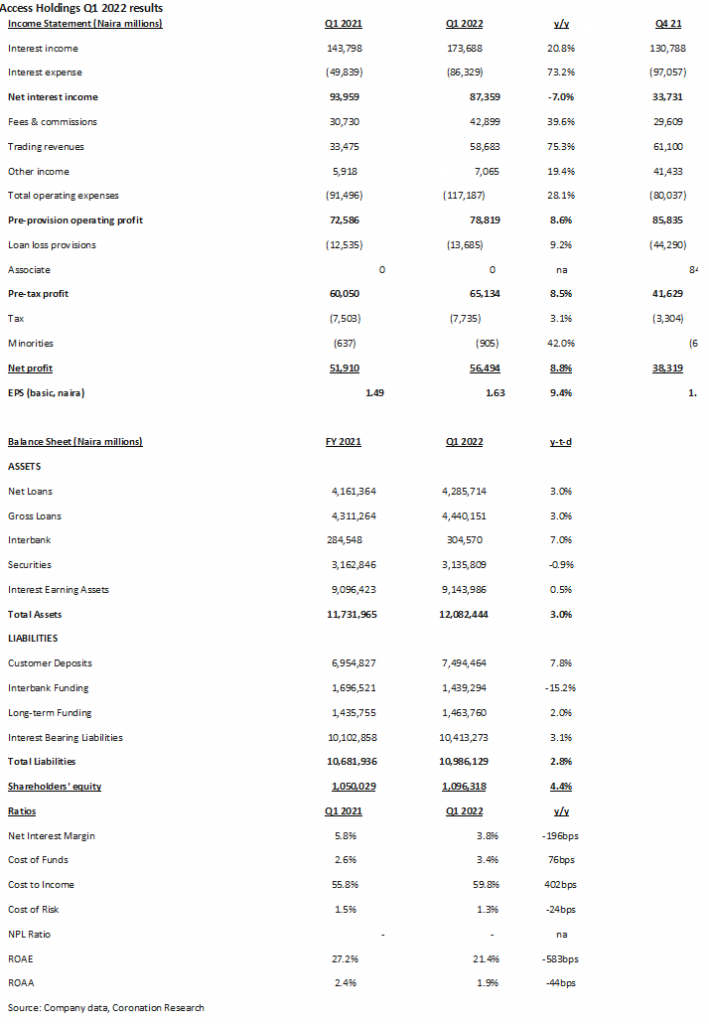
United Bank for Africa (UBA) | BUY, TP: N11.72
Q1 22: UBA’s EPS grew by 9.6% y/y, driven by NII (+14.1% y/y) and NIR (+27.1% y/y). The former was supported by solid loan growth (+6.7% y-t-d) and increased investment securities yields (+13bps y/y), while a surge in trading revenues (+52.9% y/y) drove the latter. Notably, UBA’s loan growth in Q1 22 alone has surpassed the loan growth in all of FY 21. On an annualised basis, the achieved EPS is ahead of our and consensus FY 22 forecasts by 10.0% and 17.5%, owing to better-than-expected NIR and a lower-than-expected effective tax rate.
Overall, the results were decent, in our view, with earnings growth in line with peers. We expect strong growth in both NII and NIR to continue to drive earnings in FY 22. The key investment case remains the earnings diversification benefits of its non-Nigerian African subsidiaries; its exposure to other African markets has provided a natural hedge to the troubles with its Nigerian business. We also like that its Retail strategy is yielding positive results, and it has solid asset quality metrics and a strong capital base. Accordingly, we rate the stock a BUY with a TP of N11.72. The stock is trading at a 2022 P/B of 0.3x (ROAE: 17.1%), a significant discount to its SSA peer multiple of 0.6x.
United Bank for Africa Q1 2022 results
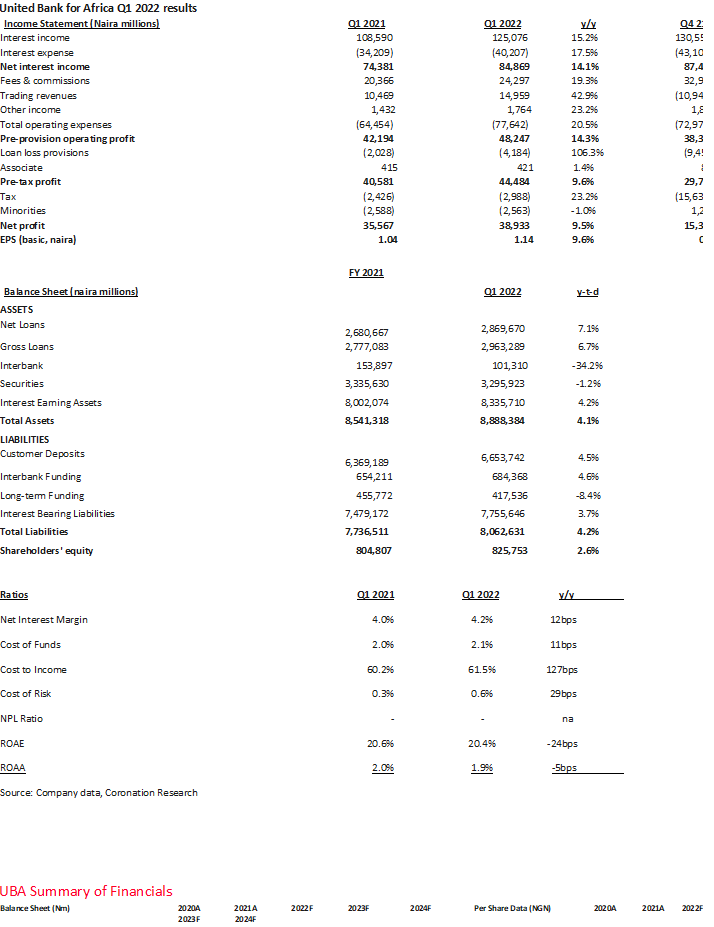
Stanbic IBTC Holdings (STANBIC) | BUY: N45.00
Q1 22: STANBIC’s EPS grew by 35.4% y/y, driven by NIR (+40.2% y/y) and NII (+47.7% y/y). NIR was supported by a surge in Trading revenues (+225.9%) which recovered from last year’s record lows. NII, on the other hand, benefitted from solid loan growth (+6.4% y-t-
d), increased loan yield (+94bps y/y) and increased investment securities yield (+167bps y/y). The group did face Cost of Funds (+73 bps y/y) pressure, with its Current And Savings Account (CASA) mix dropping by 330bps y-t-d to 62.7%. However, improved Yield on assets (+178bps y/y) offset the pressure and led to 101bps y/y NIM expansion. On an annualised basis, the achieved EPS is behind our and consensus FY 22 forecasts by 15.7% and 7.4%, owing to higher-than-expected operating expenses and a record high effective tax rate. Although Opex (+32.1% y/y) grew substantially, the rise in net revenue was able to cushion the pressure. As a result, the group’s Costto-income ratio fell by 538bps to 63.8%. Notably, STANBIC was the only bank amongst our coverage to improve efficiency.
We are encouraged by the recovery from the highly disappointing performance in Q1 21, especially the RoE uplift. We expect improved market yields will positively impact NII and NIM over the rest of the year. In addition, we hope the group can sustain the recovery in Trading revenues which have historically been a solid contributor to Net revenue. Accordingly, we rate the stock a BUY with a TP of N45.00. The stock is trading at a 2022 P/B of 1.1x (ROAE: 17.5%), a premium to its SSA peer multiple of 0.6x.
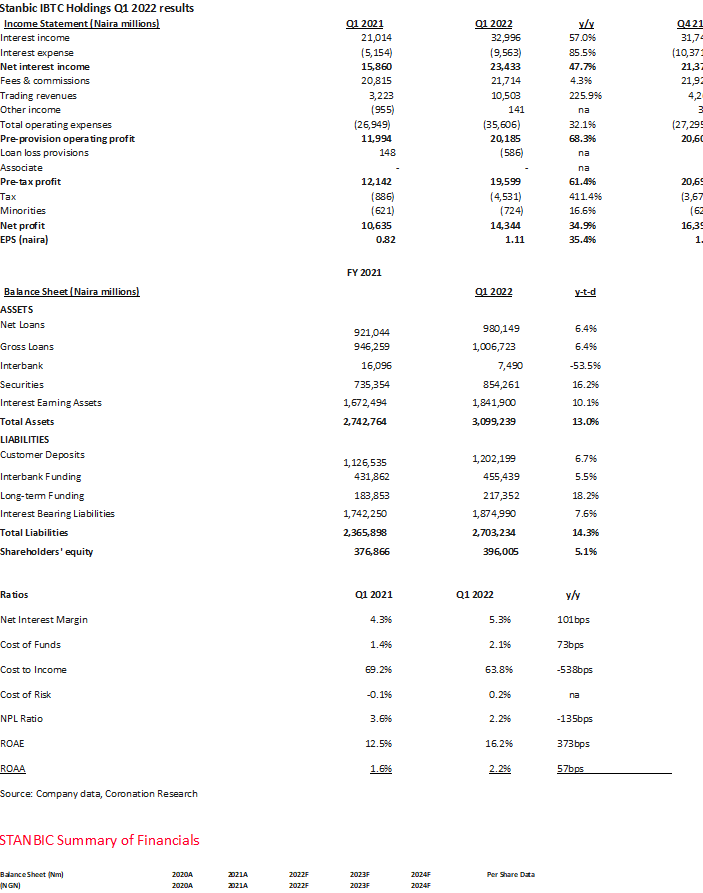
Ani (oani@coronationam.com) is a Senior Analyst at Coronation Asset Management Ltd,








